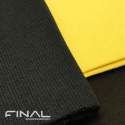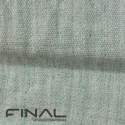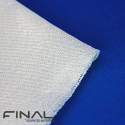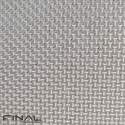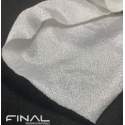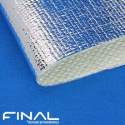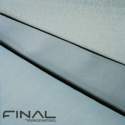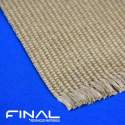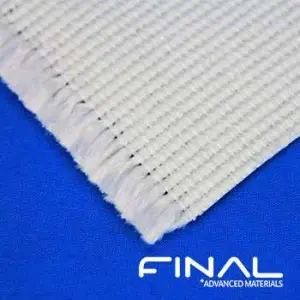High temperature fabrics
Overview: High Temperature Fabrics
Final Advanced Materials presents many different ranges of high temperature fabrics which withstand up to 2,500 °C. These products are mainly used to manufacture protection equipment, pipes insulation, heat shield and blankets. Different width and thickness are available as well as specific treatments and coatings for some items.
Applications of Fabrics
- Thermal insulation
- Safety curtains
- Expansion gaskets
- Sealing gaskets
- Heat and fire shields
- Protection equipment (apron, overall, mitts, gloves, etc.)
- Protection systems for molten metal projections
Comparative Table
|
Property |
Unit |
Aramid | Zetex® | Basalt | ZetexPlus® |
|
Area Density |
g/m² |
265 to 600 |
288 to 949 |
115 to 940 |
305 to 1,119 |
|
Width |
mm |
1,000 |
1,020 |
1,270 |
1,020 |
|
Length |
m |
50 |
45 |
100 |
45 |
|
Max. Operating Temperature |
°C |
350 |
540 |
600 |
815 |
|
Peak Temperature |
°C |
425 |
700 |
700 |
1,095 |
1S98 2S94 3E-glass reinforcement 4Inconel® reinforcement
|
Property |
Unit |
Silicate | Biosoluble | Ceramic | Zirconium |
|
Area Density |
g/m² |
500 to 1,250 |
1,2503 |
110 to 980 |
290 |
|
Width |
mm |
9101 |
1,000 |
910 to 1,270 |
610 |
|
Length |
m |
251 |
30 |
45 |
45 |
|
Max. Operating Temperature |
°C |
1,0001 |
6503 |
1,100 |
2,200 |
|
Peak Temperature |
°C |
1,1001 |
1,200 |
1,700 |
2,500 |
1S98 2S94 3E-glass reinforcement 4Inconel® reinforcement
Our Range of Fabrics
Z-Tuff®, up to 540 °C
Z-Tuff® fibre fabrics are glass fibre fabrics coated with silicone or PTFE. The Zetex® range presents a great variety of heat resistant textiles which can withstand temperatures up to 1,095 °C. Silicone-coated Z-Tuff® fabrics offer effective protection against oil and water and can withstand operating temperatures up to 260 °C and peak temperatures up to 540 °C. PTFE-coated Z-Tuff® fabrics stand out for their remarkable resistance to chemicals. They can withstand operating temperatures up to 315 °C and peak temperatures up to 540 °C. The Z-Tuff® fibre fabrics proposed by Final Advanced Materials are mainly used in the industry as insulating sleeves, welding curtains as well as an external side of protection equipment.
Applications
- Insulation sleeves
- Welding curtains
- External side of protection equipment
Aramid, up to 425 °C
Woven in plain weave, 100 % para-aramid fabrics (Kevlar®) have excellent thermal characteristics. In addition to their good insulating properties, they can reach a peak temperature of 500 °C and a continuous operating temperature of 350 °C. In addition to this, they have excellent resistance to cuts, abrasion, tearing and acids, as well as excellent mechanical properties. Available in different versions (aluminised, fleece, etc.), they are particularly suitable for the manufacture of protective clothing and thermal insulation.
100 % para-aramid (Kevlar®) fabrics always include a cross-twill woven version (2 single twills in different directions). Particularly resistant to high temperatures up to 450 °C and cuts, it is mainly used to reinforce protective clothing. Coated versions (silicone, aluminium, flame retardant, etc.) are available.
70 % Panox® / 30 % Kevlar® twill is a good alternative to 100 % aramid fabrics. The fiber is an oxidized, thermally stable, polyacrylonitrile fiber. This fiber mixture allows the textile to withstand up to a temperature of 400 °C continuously (max temperature 600 °C). It is particularly suitable for use against sparks and projected materials. It is mainly used in the manufacture of seats for the rail and air industries. An aluminium version is also available. On the other hand, its mechanical properties are inferior to a 100 % para- aramid fabric.
Applications
- Thermal insulation
- Protection shield
- Gloves
- Protection equipment
- Aprons
Z-Flex®, up to 1,650 °C
Z-Flex® fabrics are manufactured using a glass fibre fabric basis and an aluminium coating that ensures good resistance to splashes of molten metal and flames. These products also offer good mechanical strengh and chemical resistance. Moreover, they reflect up to 95 % of radiant heat, which can reach 1,650 °C, with a contact temperature of 175 °C. Z-Flex® fabrics can be found in numerous applications thanks to these properties. They are mainly used for the manufacture of fire protective clothing, fire protection systems and equipments or also equipment for automotive applications.
Applications
- Fire protection systems and equipment
- Fire protective clothing
- Industrial safety equipment
- Insulation systems
- High temperature resistant and fire barriers
- Equipment for automotive applications
- Custom manufactures
Z-Fil®, up to 540 °C
Made from continuous filament yarn, Z-Fil® fiberglass cloth is a strong, thin, lightweight, and highly flexible high temperature fabric. Z-Fil® fiberglass cloths exist in different versions: coated or treated to adapt to every needs. It is lighter than the Zetex® fiberglass fabrics woven from texturized fiberglass yarn.
Applications
- High temperature filtration
- Facing material in thermal barriers
- Lagging for boilers and pipes
Z-Fil® cloth can be treated with an acrylic coating which enable it to be used together with products of the Z-Shield® range.
Basalt, up to 800 °C
Basalt fibre fabrics are recyclable and ecological. These fabrics are mainly used for the protection for motor components and the insulation of exhaust pipes for in the motor vehicle industry. Thanks to the basalt fibre, these products can withstand peak temperatures up to 800 °C and operating temperatures up to 700 °C. This high-temperature material also offers greater resistance than glass fibre. When untreated, they are ideal as matrix for composites, whereas coated versions are used as fire barrier.
Final Advanced Materials provides basalt fibre fabrics untreated or with a clear water based Polyurethan (PU) coating. This treatment reduces the mechanical irritations caused by the stiffness of loose filaments and stabilises the fabric.
Applications
- Exhaust systems
- Thermal insulation (piping)
- Electrical insulation
E-glass, up to 700 °C
E-glass fibre fabrics are manufactured using E-glass filaments ranging from 6 to 9 µm. This composition prevents the possible risks of build-up in the respiratory system and skin irritation. These products can withstand peak temperatures up to 700 °C and operating temperatures up to 550 °C. These fabrics are used in the industry for the manufacture of compensators, gaskets, thermal reflectors or protective clothing.
The E-glass fibre fabrics are available untreated or with a vermiculite, silicone or aluminised coating.
Applications
- Gasket
- Compensators
- Heat reflectors
- Curtains
- Blankets
- Protective clothing
Zetex®, up to 700 °C
Zetex® fibre fabrics are manufactured using textured glass fibres, an inorganic material that poses no health risks. The Zetex® fibre is chemically inert and offers good abrasion resistance, excellent chemical resistance as well as recognised rot-proof properties. They ensure excellent thermal and insulating properties. Zetex® fibre fabrics are used for numerous applications in the industry including the manufacture of gaskets, compensators, heat reflectors or even protective clothing. They can withstand peak temperatures up to 700 °C and are used at an operating temperature of 540 °C.
Applications
- Seal
- Heat reflectors
- Curtains
- Covers
- Protective clothing
ZetexPlus®, up to 1,095 °C
ZetexPlus® fibre fabrics are woven from highly texturized continuous glass filament and show great insulation and thermal properties. They can withstand peak temperatures up to 1,095 °C and operating temperatures up to 815 °C. ZetexPlus® fibre fabrics also stand out for their great chemical resistance as well as their mechanical resistance. ZetexPlus® features insulating textiles and heat protection with numerous applications: compensators, gaskets, protective covers and clothing, curtains, heat reflectors, etc.
Applications
- Gasket
- Compensators
- Heat reflectors
- Curtains
- Covers
- Protective clothing
Silicate, up to 1,200 °C
Silicate fibre fabrics are inorganic, and contain no toxic substances. With a diameter of 9 μm, these fibres pose no hazard to health during handling. The good thermal and mechanical properties of these products make them excellent replacements for ceramic fibre products. Silicate fibre fabrics also offers great mechanical and chemical resistance and are therefore suitable for high-temperature applications, such as the assembly of protective cover against metal splashes and sparks. Moreover, they can withstand peak temperatures up to 1,100 °C and operating temperatures up to 1,000 °C.
The fabrics are available untreated or with a pre-setting or a vermiculite coating. They enhance the properties of the textile and stabilise them through the action of heat.
Applications
- Component for protective clothing’s assembly
- Protective cover against metal splashes and sparks
- Heat protection
- Electrical insulation
- Protective curtain
Biosoluble, up to 1,200 °C
Biosoluble fibre fabrics are reinforced with E-glass fibre or heat-resistant steel. They therefore offer better mechanical properties. Depending on the material used, these products can withstand operating temperatures up to 1,050 °C and peak temperatures up to 1,150 °C. Moreover, the biosoluble fibres are a non-carcinogenic insulation material. During their manufacture, they are also thermally treated to reduce airborne fibres and dust. Thanks to their insulation properties, these fabrics are used in the industry for the insulation of pipes, exhausts, furnaces or electrical insulation but also for metal working.
The biosoluble fibre fabrics proposed by Final Advanced Materials are available with a thickness ranging from 2 to 3 mm.
Applications
- Insulation for pipes and exhausts
- Electrical insulation
- Metal working
- Insulation of furnaces
Alumina, up to 1,300 °C
Alumina, also described as aluminum oxide, is a white powder which shows high stability in response to chemical corrosion. Final Advanced Materials can supply fabrics comprised of over 72 % alumina fibre which allows the products to withstand operating temperature of 1,200 °C and peak temperature of 1,300 °C. Alumina fabrics contain no toxic substances, asbestos or boron. They are non-irritating, and feature no outgassing, in the interests of improved safety.
Applications
- Protective covering against metal splashes and sparks
- Thermal protection
- Thermal insulation of valves, flanges, turbines and boilers
- Thermal insulation of pipes
- Expansion joints
Ceramic, up to 1,700 °C
Ceramic fabrics are mainly used in the industry as fire barrier or for insulation and are particularly suitable as heat shield. Their composition differs in terms of alumina (Al2O3) levels and they can withstand operating temperatures up to 1,400 °C as well as peak temperatures up to 2,000 °C. The thermal properties of these fabrics exceed those of other fibrous material, such as aramid, glass or silica.
The fabrics are untread or available with a heat cleaned or heat treated finish. They reduce airborne fibre, the risk of irritations for customised applications and the amount of smoke produced during exposure to high temperatures. Moreover, these treatments can prevent the physical degradation of the ceramic fibre when the product is subjected to hot and humid conditions for an extended period.
Applications
- Fire shield
- Heat shield
- Gasket
- Expansion joints
- Thermal protection
- Manufacture of composites
- Curtains and lining
Zirconia, up to 2,230 °C
ZYW zirconia fibre fabrics are flexible technical textiles composed of yttria stabilized zirconia fibers. They are manufactured using the original Zircar process by Zircar Zirconia and are constructed of continuous individual filaments mechanically interlocked in a woven structure. This construction offers extreme temperature and chemical resistance in a flexible form. They can withstand peak temperatures up to 2,230 °C and operating temperatures up to 2,200 °C. Zirconia fibre fabrics can be used as battery separators at high energy, thermal insulators in crystal growth furnaces and hot gas filters. They can be easily cut for custom applications.
Final Advanced Materials proposes untreated ZYW zirconia fibre fabrics.
Applications
- Thermal insulation of crystal growth furnaces
- Battery separators at high energy
- Hot gas filter
- Custom applications
Treatments & Coatings Newtex
In addition to the standard coatings that characterize Newtex products (vermiculite, aluminium, etc.), they can be treated or coated to increase their mechanical or physical properties or their colour:
• Colors: red, blue or orange.
• Heat cleaned - HC: the fabric is treated at high temperatures to remove broken fibres and binder and lubricant remnants to reduce smoke generation or flying fibres.
• Fabrication treatment - FAB: this is an acrylic coating applied to one side of the fabric to dimensionally stabilise it and increase its resistance to abrasion.
• Regular treatment - RT: it is an acrylic coating applied on both sides of the fabric in order to stabilise it dimensionally and increase its resistance to abrasion, but also to limit irritation related to contact with the skin.
• Oil and Water Repellent - OWR: this coating increases the fabric's resistance to oil, water and abrasion.
• Rewettable - RW: this inorganic coating allows the textile to be applied and shaped directly on site.
| Zetex® | ZetexPlus® | Z-Fil® | Z-Flex® | Z-Tuff® | Z-Shield® | |
|
Colour |
x |
x |
x |
x |
||
|
HC |
x |
|||||
|
FAB |
x |
x |
||||
|
RT |
x |
|||||
|
OWR |
x |
x |
||||
|
Rew |
x |
|||||
|
Aluminum |
x |
x |
||||
|
Acrylic |
x |
x |
||||
|
Silicon |
x |
x |
||||
|
PTFE |
x |
x |
||||
|
Vermiculit |
ZetexPlus® |
x |
||||
|
Silver |
x |
Physical variables included in this documentation are provided by way of indication only and do not, under any circumstances, constitute a contractual undertaking. Please contact our technical service if you require any additional information.

High Temperature Alumina Fabrics 1300°C
High Temperature Aramid Fibre Fabrics 400 °C
High Temperature Basalt Fibre Fabrics 800 °C
High Temperature Biosoluble Fibre Fabrics 1,150 °C
High Temperature Ceramic Fabrics 2,000 °C
High Temperature E-Glass Fibre Fabrics 700 °C
High Temperature Silicate Fibre Fabrics 1,100 °C

High Temperature Z-Block® Fabrics 980°C



